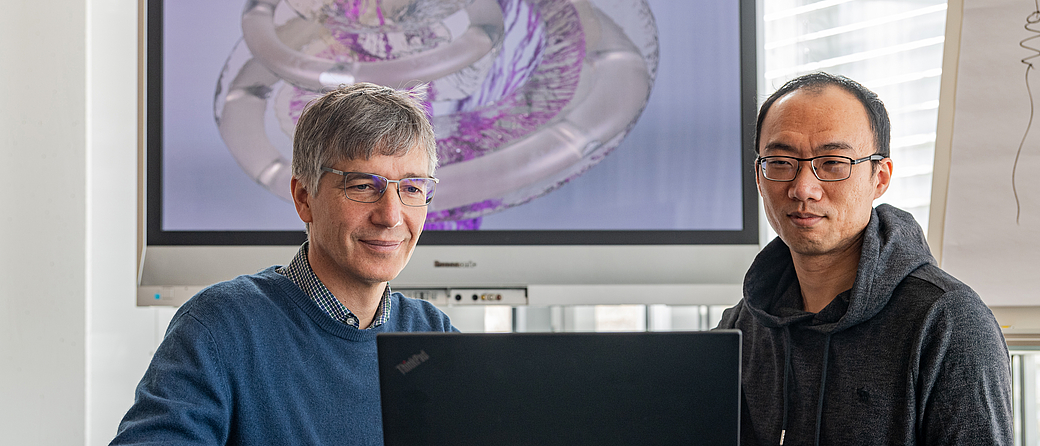With cochlear implants (CIs) individuals with severe to profound hearing loss can communicate verbally once again. However, many basic properties pertaining to the electrical stimulation of the auditory nerve with CIs are not yet fully understood. That is why Prof. Werner Hemmert and his team at the Munich Institute of Biomedical Engineering (MIBE) are developing computer models and researching which information passes from the CI to the nervous system. The German Research Foundation (DFG) is funding the project for three further years.
Cochlear implants convert acoustic signals into electrical impulses and stimulate the auditory nerve. Since the highly complex processes for individual nerve cells cannot be measured directly in humans, Werner Hemmert, Professor of Bio-inspired Information Processing, and his team are developing computer models. "With over one million deployed cochlear implants, these are currently the most successful neuroprostheses. Our aim is to understand the process of hearing with the implants in greater detail so that we can further improve CIs in the future," says Hemmert.

At this point content of an external provider (source: www.youtube-nocookies.com) is integrated. When displaying, data may be transferred to third parties or cookies may be stored, therefore your consent is required.
You can find more information and the possibility to revoke your consent at our privacy statement.
Video: Rafael Vorländer, Erik Hainzlmeier / TUM
From scanned temporal bones to precise computer models
The cochlea is embedded in the temporal bone, a particularly hard part of the skull. Based on high-resolution scans of petrous temporal bones, Hemmert's team has already developed virtual models that precisely reproduce the human anatomy of the cochlea. These models also simulate the CI electrodes and individual nerve cells. "The electrodes of the cochlear implant emit electrical impulses. With our simulation, we can predict which nerve cells are activated and how the impulses propagate along individual nerve cells," says Albert Croner, who is conducting research on the project as part of his doctoral thesis.
The team from the Technical University of Munich (TUM) will work with researchers from the inner ear laboratory at the ENT Clinic of the Medical University of Innsbruck to further refine its models in the collaborative project "Fine-Structure-Based Models for Cochlear Implant Advancement”.
"In the new phase of the project, we are looking to include additional parameters, such as the distribution of ion channels and the position of cell bodies. Our goal is to create a framework in which the individual parameters can be easily adjusted in the future. We also want to compare the computer models with measured data from CI users to see how well simulation and reality match," says postdoctoral researcher Siwei Bai.
Damaged nerves and temporal effects influence speech coding
The researchers will also investigate how damaged nerves in specific areas affect the quality of speech coding. This information could be used to better adapt CIs, for example by selectively switching off electrodes over regions with damaged nerves.
If the same nerves are stimulated for several tenths of seconds, their ion channels adapt and temporarily cease to respond to every impulse. The team wants to investigate the causes of these temporal effects. They hope the results of this project will help them to better understand and simulate the implant-aided hearing process to facilitate improvements in CI technology.
More Information
- Researchers from TUM and the Medical University of Innsbruck will work in the project “Fine-Structure-Based Models for Cochlear Implant Advancement”. The teams are headed by Prof. Werner Hemmert and PD Dr. Rudolf Glückert.
- The project is funded by the German Research Foundation (DFG) and the Austrian Science Fund (FWF).
- Prof. Werner Hemmert conducts research at MIBE, an Integrative Research Institute within TUM. At MIBE, researchers specializing in medicine, the natural sciences, engineering, and computer science join forces to develop new methods for preventing, diagnosing or treating diseases. The activities cover the entire development process – from the study of basic scientific principles through to their application in new medical devices, medicines and software.
Contact Media Relations
Media Relations MIBE
presse@bioengineering.tum.de
Scientific Contact
Prof. Dr. Werner Hemmert
Technische Universität München
Munich Institute of Biomedical Engineering (MIBE)
Professorship of Bio-inspired Information Processing
Tel.:+ 49 89 289 10853
E-Mail: werner.hemmert@tum.de
